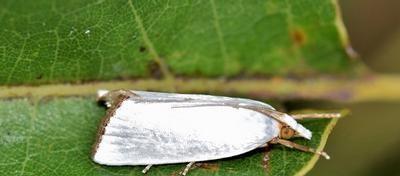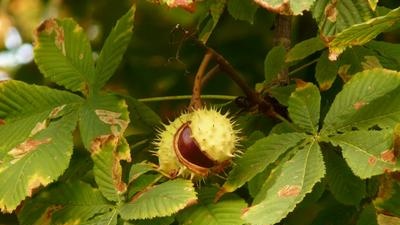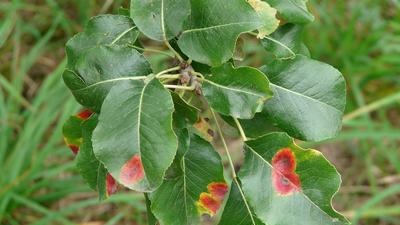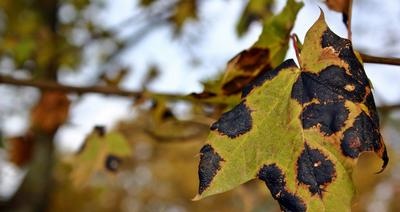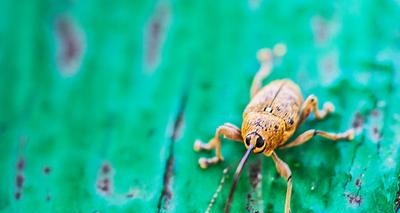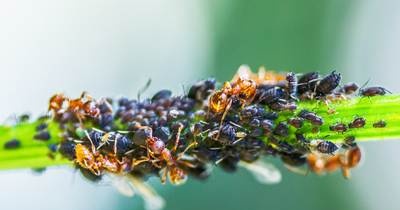Miner moths and control measures |
|
As a result, the trees weaken, the fruits become small and do not ripen, the number of fruit buds laid is reduced, which reduces the yield the next year.
In the upper-sided moth, older caterpillars overwinter, and in the lower-sided one - pupa and, less often, caterpillars in mines on fallen leaves. In late March - early April, they begin to pupate. Butterflies fly in late April - early May. Pests of both species develop in three generations.
Caterpillars of the first four instars die in dried or fallen leaves, and the last one. - pupate prematurely. Leaf damage by crumpled crumb moth is sometimes mixed with leaf damage by the miner moth, Lyonetia clerkella L., because they make similar serpentine long mines.But in a crimped crumb moth, its narrow part is short and turning into a wider, almost spotty, and in a mining moth it is narrow and sinuous throughout. The caterpillar of the first species pupates in a rounded, flattened, closed cocoon of pale yellow color, and in the second, in a white cocoon, open at both ends, the extension of which passes into a thread, on which a cocoon is suspended between two points of the leaf. Twisted crumb moth overwinters in the pupal stage in a cocoon in the soil. The flight of the first (overwintered) generation is observed at the beginning of leaf opening at an average daily temperature of + 10 °. After a few days, the females lay eggs, which develop in 10-14 days. The hatched caterpillars of the first generation feed for 28-36 days and then pupate. The period of emergence of butterflies, the laying of eggs and the hatching of caterpillars from them are stretched, therefore, in nature, generations overlap one another. The flight of the second generation butterflies is recorded in mid-June. The development of their eggs is faster by 6-8 days. Caterpillars also grow faster - in 20-28 days. The flight of the third generation butterflies is observed at the end of July - August, and the development of their caterpillars - in August, September and even at the beginning of October. Wintering pupae already appear in September.
Most scientists believe that the main reason for the mass reproduction of mining moths is the use of DDT in gardens, which causes the death of their natural enemies (poachers and chalcid) without destroying the pest itself. In those orchards where DDT and sevin have been used in the fight against the codling moth for several years, the number of mining moths is increasing. Consequently, in the breeding centers, it is necessary to replace these drugs, for example, with chlorophos, which, with its timely and correct use, frees trees from mining moths, fruits from the codling moth, and for entomophages it is not so much harmful as DDT and sevin. Spraying with chlorophos against the moth excludes special sprays against moths. However, it should be borne in mind that chlorophos gives a positive result only in the fight against young caterpillars, which are in the superficial epidermal mine.
It is necessary to spray no later than the second decade of May, when the first and second generation caterpillars are in the mines (160 g of 90% crystalline chlorophos, or 200 g of 52% chlorophos per 100 l of water). The drug should not be mixed with Bordeaux liquid, it must be replaced with cineb or tsiram. In addition to chlorophos, thiophos, or tri-chlorometaphos-3 at a concentration of 0.2%, or metathione E-50 at a concentration of 0.1%, can be used.
In addition to chemical measures, it is recommended to use agrotechnical measures. In the fall, after leaf fall or early in the spring (before the butterflies fly out), it is necessary to plow or dig (up to tree boles) areas of the garden where there are fallen leaves with mines, and pupae to a depth of 10-15 cm. At the same time, the butterflies cannot get out to the surface and die ... V.V. Vereshchagina Similar publicationsRead nowAll recipesRead now |
 In the last 10-15 years, in some areas where horticulture is well developed, there has been a strong reproduction of mining moths. Their damage causes a decrease in the assimilation surface of the leaves, since they are completely covered by mines (tunnels) of caterpillars, and sometimes fall off.
In the last 10-15 years, in some areas where horticulture is well developed, there has been a strong reproduction of mining moths. Their damage causes a decrease in the assimilation surface of the leaves, since they are completely covered by mines (tunnels) of caterpillars, and sometimes fall off.